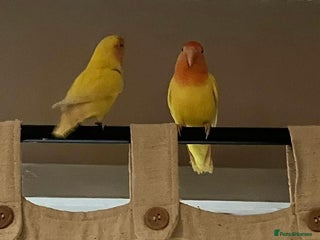Male Lovebirds Birds for sale
15 Male Lovebirds Birds for sale
Lovebirds, also known simply as love birds, are small, vibrant parrots originating from the African continent. These birds are renowned for their strong pair bonding and affectionate nature, which is what gives them their charming nickname. Physically, lovebirds are compact with a stocky build, often displaying a bright green plumage with various species showing distinctive colour patches such as peach, blue, or rosy faces. Their size and colourful feathers make them a popular choice among bird enthusiasts in the UK. Temperamentally, lovebirds are lively, social, and playful creatures that thrive in pairs or groups. They are known for their affectionate behaviour, often seen cuddling or grooming their partners, making them a symbol of love and companionship. As pets, they require spacious cages, mental stimulation, and social interaction to remain happy and healthy. Their suitability for UK bird keepers comes from their manageable size and engaging personalities, although prospective owners should be prepared for their noisy calls and exercise needs. Keywords to note: lovebirds for sale, love birds price, peach faced lovebird for sale, rosy-faced lovebird price.

Lutino Peach Faced Lovebird - Female
Lovebirds
Peachy is a very healthy 5 month old female Lutino peach faced Lovebird. DNA Proven. Selling due to her sibling being male. Price is for bird only. Large Cage available for an extra £40. Southampt

Blackmasked baby lovebird for sale.
Lovebirds
I have young lovebirds for sale.DNA confirmed. They are from June,July and October.Very active and happy birds.Blackmasked £60 each. Blue 2 males,4 females. Green 3males,4 females. I'm a breeder and

Lively lovebird for sale
Lovebirds
This beautiful male lovebird is for sale as due to unforeseen circumstances I can no longer look after him. He would do well alone or with a female to keep him company. Cage and toys included

Lovebirds
Lovebirds
Two beautiful love birds and cage with full set up. Blue-male Green-female Bought them not realising they’re going to be stuck in the cage as we have dogs that don’t like them. Would love them to

Love birds
Lovebirds
Very nice and healthy love birds Blue pair £100 Parblue violet euwing female £100 Yellow/Violet opline female £100 Opline Pale fallow red eyes female and split red eyes male pair £300.

These are Peach-faced (Rosy-faced) Lovebirds
Lovebirds
Agapornis roseicollis These are Peach-faced (Rosy-faced) Lovebirds Hi guys I have 2 male lovely lovebirds about 2 yers old the are ready to breed the are Healthy birds. We are moving from house for t

Lovebirds dna'd fischers lovebirds
Lovebirds
I have 4 healthy outdoor aviary bred fischers lovebirds. X3 are 2025= x2 hen x1 male X1 is 2024= hen All are dna'd Fed a standard parakeet mix along side various fruits and vegs. £60 each. £60 each

Lovebirds
Lovebirds
I'm selling these 2 lovebirds the blue one is a female and the orange one is a male I need them paired together they are not tame but are just under a year old so possibly can be tamed with time

EUWING OPLINE YELLOW FACTOR LOVEBIRDS
Lovebirds
BEAUTIFUL OPLINE SPLIT BLUE LOVEBIRDS FOR SALE . YELLOW FACTOR EUWING DARK VOILET GREEN BIRDS . GREEN OPLINE SPLIT BLUE . YELLOW (DECINO POSSIBLE INO ). ALL BIRDS ARE VERY HEALTHY AND ACTIVE . ALL B

Male
Lovebirds
Hi 2 canaries singing good £30 each come with Owen cage water bottle , food dish and more … also 1 pair with Owen cage £50 , collection in Leeds Thanks

Lovebirds for sale
Lovebirds
Hi I have two healthy lovebirds for sale. The orange one (named Nodo) I’m guessing is female and the white one (named Nuna) I’m guessing male. They grew up together and get along well but aren’t bonde

lovebird
Lovebirds
i have love bird male and femal in leeds for sale with cage you can contact me wathsapp ************

Love birds
Lovebirds
3 young male's 5 months old £70 with DNA test available . All happy healthy birds bred in a clean environment by myself. Genuine buyers only no time wasters.

Male an female lovebirds
Lovebirds
These are less than 6months old beautiful lovebirds. Still timid but getting use to being held. Collection only contact number ************

Cockertiels
Lovebirds
Selling cockerties 2 males and 1 female. They are lovely birds have been in aiverys with other birds and have all gotten on fine
FAQs
Should I get 1 or 2 lovebirds?
Deciding between one or two lovebirds depends on your lifestyle and availability. A single lovebird can bond closely with you if you provide daily interaction, play, and mental stimulation. However, if you have limited time, a pair of lovebirds might be better as they entertain and bond with each other, reducing loneliness but potentially showing less interest in human interaction. If keeping two, introductions should be gradual and supervised to avoid fights, and be aware that pairs may breed, which requires additional consideration.